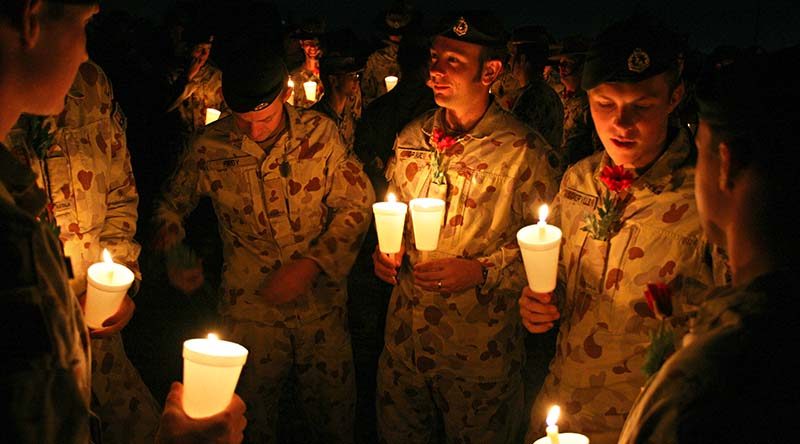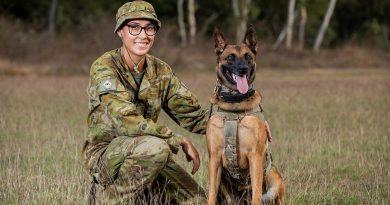First annual ministerial statement on veterans and their families
Share the post "First annual ministerial statement on veterans and their families"

Statement to Parliament by Minister for Veterans’ Affairs Dan Tehan
14 August 2017
I ask leave of the House to give the first annual Ministerial Statement on Veterans and Their Families.
As the Prime Minister has said, in these centenary years of Anzac, we best honour the Diggers of the First World War by supporting the servicemen and women, the veterans and the families of today.
CAPTION: Members of Overwatch Battle Group–West get ready to participate in an ANZAC Day at a Dawn Service at Talil, Iraq, 2008. Photo by Brian Hartigan.
It is important that all Australians understand the unique nature of service. It is important that all Australians understand what support they currently provide to our veterans. It is important that all Australians understand where our support needs to be targeted into the future.
For the men and women who serve or have served our nation; for their husbands, wives, and children; for their mothers and fathers, sisters and brothers – this Ministerial Statement is for you.
There are currently around 58,000 Australians serving in our Defence Forces. Some will serve overseas. Others will serve in barracks and bases around our country. No matter who they are, all of them will become veterans.
In the Australian community, there are an estimated 320,000 veterans who have been deployed. Many thousands more will not have seen service outside of Australia. These men and women have worn their uniform in both peace time and in conflicts. They have given service from World War Two to the current deployments in Iraq and Afghanistan.
On average, our ADF personnel will serve for around eight and half years. Each year, around 5,200 will leave. Some will leave service and move on to new careers, using the skills and experience of their time in Defence to strengthen our workforce. Some will be business men and women, some will be community leaders, some may enter this Parliament and some will go on to be Governors-General.
However, some may not have a choice in leaving. Through medical or administrative discharge, their time in Defence will come to an end.
For these veterans, it might be the simple things that are harder. It may be that they haven’t considered what the future may hold. It may also be that they carry with them the burden of service – mental health conditions or injuries that will require support.
A key focus of this Government is on how these men and women transition out of the Australian Defence Force.
In the last twelve months, over 1,400 members of the Australian Defence Force separated for reasons not of their choosing. Ten years ago, just over 740 members separated involuntarily.
How we help these men and women and provide for their transition is integral to ensuring that none of them fall through the gap between Defence and civilian life.
It is at this point that we as a Government, and as Australians, can make a real difference. This task begins in the Department of Defence and continues with the Department of Veterans’ Affairs.
Currently, the Department of Veterans’ Affairs supports about 291,000 Australians. Just over half of these people are veterans or currently serving members of the ADF. Around 48 percent are women. Around 82,000 are widows or widowers and around 2,500 are children of veterans.
Today, more than 203,000 of DVA’s clients are 65 years or over while about 23,000 are under the age of 40.
This is the state of our veterans in Australia. They are representative of every aspect of service and from every walk of life. They are old and young. They are from the country and the city.
It is why, in the last twelve months, the Government has held the first Female Veterans Forum and the first Veterans Families Forum. It is why we have held the first meeting of State and Territory veterans ministers, to provide input on how we can work together across all levels of government on issues such as veteran homelessness.
Serving our veterans requires our Government and Australians to acknowledge the various backgrounds and needs of the veteran community in order to put our help where it is most needed.
Australians should be proud that we recognise the importance of service and remain one of the only countries with an independent Department to serve our veterans. The Government is committed to maintaining a stand-alone Department for our veterans.
This year, DVA will provide over $11 billion in payments and services. That includes pensions, income support, compensation, healthcare, rehabilitation, counselling services, transport, transition assistance, home care, housing, commemorations, education and grants funding.
Around $6.2 billion, or 54 percent of the Department’s budget, will be spent on providing veterans and their families with income support and compensation.
Around $5 billion, 44 percent of the Department’s budget will be spent on meeting the healthcare needs of veterans and their families.
I am pleased to note that in the recent renegotiation of hospital agreements we have secured priority for private rooms for veterans, wherever possible.
I’d also like to note that the Department of Veterans’ Affairs provides medical services to veterans and war widows by making payments to providers that are significantly higher than Medicare rebates. This ensures the widest possible availability of providers for those we serve.
Around 0.8 percent of the Department’s budget will be spent on commemorations and maintaining memorials and headstones.
Over 95 percent of the Department’s budget comprises payments that are legislated, fully-funded and uncapped.
If there is a need, it will be funded and the Department will provide assistance.
For example, in the 2017/18 Budget, DVA is estimated to spend $11.3 billion but if more veterans present with eligible claims, this figure may be higher.
The Department employs around 2,000 staff throughout Australia. About a third of them are headquartered in Canberra. The rest are spread across offices in each state and territory, in capital cities and regional towns.
In a typical 9 to 5, five-day week, DVA will process about 95 compensation or income support forms every hour, receive two letters or emails every minute, and take a phone call every couple of seconds.
The administration costs of the Department represent less than three cents of every dollar it spends.
DVA works hard to provide quick and strong support for veterans and their families. But it is not perfect. People make mistakes. As a result, the Department will not always get it right.
In this first Ministerial Statement on Veterans and Their Families, I also want to reflect on what we need to do better.
Some in the veteran community have found the Department of Veterans’ Affairs to be adversarial, slow or bureaucratic.
In the Department’s satisfaction survey, we have seen a distinct decline in overall satisfaction from 93 percent in 2010 to 83 percent in 2016. While this number is still high, it represents where the Department could have served veterans better.
For example, at the Veterans’ Review Board there were over 2,900 decisions made in 2015/16. Of these, nearly half were made to change or reverse the decision of the Department.
If veterans are not satisfied with a decision of the review board, they may apply to the Administrative Appeals Tribunal.
In 2015/16, 223 of the 307 rulings of the Administrative Appeal Tribunal were made against the Department.
We know that getting decisions right the first time can make an enormous difference to veterans. We are working to reduce the number of cases that go to administrative review. This will be good news to our volunteer advocates, who assist veterans with their appeals.
Recently, we have implemented a trial of Alternative Dispute Resolution for veterans who choose to appeal a decision with the Veterans’ Review Board. As a result, cases that may have taken up to a year to resolve have been resolved in as little as three months. We are now rolling this out nationwide.
In 2013/14, wait times for initial liability under the Military Rehabilitation and Compensation Act and for the Safety, Rehabilitation and Compensation Act were 144 days and 160 days respectively. They have now come down to 107 and 110 days respectively.
However, permanent impairment claims have gone from 129 days and 112 days to 156 and 148 days respectively. This is not good enough and the Department has been tasked to improve it.
The Department is working on ways to leverage technology to deliver better services and cut paperwork. For example, some claims that used to take 117 days to process now only take 60 days. These trials are promising and the Department is looking at how we can implement them across the system.
However, we can only have a better service from DVA if they have the tools to do the job. We have listened to the veteran community on the need to put them first with DVA.
We have made the first serious investment in years into the Department – $166.6 million towards making DVA a 21st century Department with a 21st century service culture. This includes a significant investment in upgrading DVA’s computer systems and processes. Claims and wait times will be cut by this investment, something that is long overdue.
One of the most important services we provide is mental health support. In this first Ministerial Statement on Veterans and Their Families, I would like to focus on the issue of veteran mental health.
The Department of Defence and the Department of Veterans’ Affairs spend more than $244 million a year on providing mental health support and treatment to current and former ADF members. This includes services provided by GPs, psychologists, psychiatrists, social workers and hospitals as well as pharmaceuticals and online information and support tools.
It also includes access to the Veteran and Veterans’ Family Counselling Service (VVCS), which is at the frontline of the Government’s veteran mental health support response and has been for more than 35 years. This service is part of the strong legacy of our Vietnam veterans, whose experience has informed how we care for modern veterans.
VVCS provides free and, importantly, confidential counselling and support for current and former members of the ADF and their families.
It has 26 centres around Australia and a network of more than 1,100 outreach clinicians. It delivers services to more than 27,000 members of the ADF community and their families annually.
We know, the burden of mental health conditions can also fall on families of veterans.
Over two years the Government has expanded VVCS to include as many families as possible. The recent Budget has provided $8.5 million to continue to expand eligibility for VVCS.
We recognise that as a result of a veteran’s service, children can be affected. In March the Government allocated $2.1 million over two years to the Australian Kookaburra Kids Foundation to deliver age appropriate mental health education to the children of veterans with a mental health condition.
We know mental health treatments work best when intervention is early. The faster that we provide support to veterans, the better their chances of recovery and for mitigating any long-term impact.
For many years, Governments only provided mental health support when a veteran was able to prove their condition was caused by their service.
Last year, the Turnbull Government decided that Australia should provide its veterans with free and immediate mental health treatment.
Under the scheme, any veteran who had served one day in the full-time ADF would be given full cover for five of the most common mental health conditions: post-traumatic stress, depression, anxiety, alcohol abuse, and substance abuse.
For the first time, an eligible veteran with one of these conditions didn’t have to prove it was caused by service. From the moment of contact with the Department to register their need for support, we would be there for them.
The Turnbull Government has now completed this reform.
In this year’s budget, we have covered all mental health conditions. From now on any veteran of the full-time ADF will get free and immediate mental health cover.
This programme of non-liability mental healthcare is fully funded and completely uncapped – if there is a need it will be met.
This common sense approach to mental health support is the biggest change in veterans’ policy in decades and we must continue to build on it.
As all Australians know, one suicide is one too many. Suicide affects all areas of our community – eight Australians a day take their own life and it remains the greatest cause of death for men between the ages of 14 and 44.
As we have seen, our veterans and members the ADF are sadly not immune. We are determined to address suicide in our community. Everyone has a role to play.
Last year the Government commissioned the Australian Institute of Health and Welfare (AIHW) to provide the first accurate, robust data ever produced on suicide among the serving and ex-serving populations.
This study was independent of the Department of Veterans’ Affairs. This research is providing a greater understanding on where and how to help those who are struggling.
The AIHW study has revealed the suicide rate is 53 percent lower for men serving full-time in the ADF and 49 percent lower for men in the reserves when compared to the general population.
In all male ex-serving members, the rate of suicide is 13 percent higher than the general population.
However, men who have left the ADF between the age of 18 and 24 have twice the risk of suicide compared to their peers.
The Government will continue to independently track this data in order to provide support.
This information is informing our approach to suicide prevention.
The Government also asked the National Mental Health Commission to review the suicide prevention services offered by Defence and DVA.
Their comprehensive report told us to target four areas:
1. Improving suicide prevention and mental health support for serving ADF, veterans and their families.
2. Improving the transition process from the ADF.
3. Improving family support.
4. Transforming DVA’s systems, processes and culture.
These reviews helped inform the Government’s action on veterans’ mental health in this year’s Budget, which included an additional $58.6 million in mental health funding.
As part of this, the Government is investing $9.8 million to pilot new approaches to suicide prevention and improve care and support available to veterans. This will include funding to increase support for those discharging from hospital and who are at risk.
The Department of Veterans’ Affairs also has a range of suicide awareness and prevention resources, known collectively as Operation Life.
As I have already said, the moment a member of the ADF becomes a veteran is crucial so we must do better at the transition Process.
Just as members of the ADF prepare for being posted to a deployment, we should prepare them for posting to civilian life.
To give some idea, when a soldier leaves the ADF they may have never filled out a rental application, written a resume or used a Medicare card.
We know that for some ADF personnel, the transition period can bring significant change and with that change comes stress.
For example, until January last year the Department of Defence didn’t have the capacity to notify the Department of Veterans’ Affairs when a serving member became a veteran. Until a recent change in policy, DVA only knew of around one in five ADF members leaving Defence.
An important component of this is the Early Engagement Model. The aim of the Early Engagement Model is that when a serving or former ADF member needs DVA in the future, they will already be registered with the Department. This will reduce claims processing times.
Another reform that will improve our processes will be to allow Defence, the Department of Veterans’ Affairs and the Commonwealth Superannuation Corporation to share medical information on a veteran in order to save them from having to undergo up to three separate medical assessments.
Additionally, this Government took to the last election a commitment to ‘No Discharge Without Documentation’. This initiative will ensure all separating members of the ADF leave with the necessary documents to make the transition phase more seamless. This includes their medical and training records.
This ongoing work is led by a Transition Taskforce that was established after the last election.
Veterans need to be able to walk into civilian life with confidence and dignity.
This Government is committed to making that happen through the Prime Minister’s Veterans’ Employment Initiative.
As the Prime Minister has said, this is not about charity. We are not asking businesses to engage in some sort of philanthropic exercise. We want to remind business leaders that the servicemen and women of Australia have unique skills and extraordinary experience.
The Initiative is about helping business appreciate the unique skills former ADF members can bring to a job. Launched last November, it highlights the Government’s commitment to improving the support provided to veterans during their transition out of the ADF.
Through the program’s Industry Advisory Committee on Veterans’ Employment we will develop strategies for business to recognise and transfer the talents of our veterans into post-service careers.
Already over 1,000 jobs on the jobactive website have been identified as veteran-preferred and we will have more to say on The Prime Minister’s Veterans’ Employment initiative in the coming months.
Helping our former Defence personnel find meaningful post-service careers is one of the best ways we can honour their service and sacrifice.
A key reason for giving this statement is to outline how Australia can do better for its veterans.
As a Government we commit today to the following:
1. A stand-alone Department of Veterans’ Affairs;
2. A Department that focuses on the needs of the veteran first; and
3. A stronger voice for the veterans’ community.
It is imperative that Australia continues to provide veterans with their own Department. It is the best way that their service and unique needs will be recognised and provided for.
However, we acknowledge that the Department must focus on the needs of those it serves as a priority. Veteran Centric Reform, providing funding for the upgrade of the Department’s systems, and an improved service culture are the first steps.
Veterans’ Affairs legislation is complex. Across three Acts, the support that is provided to different ages and cohorts can be difficult to navigate. Parliament is looking at how we can begin to modernise and simplify this legislation. This includes placing all the relevant Acts under the control of the Minister for Veterans’ Affairs.
In any effort to provide support, we should also look to how we can provide payments faster. The time between making a claim and receiving rehabilitation can be lengthy. This year’s Budget has provided for a pilot to provide rehabilitation to veterans as soon as they have submitted their claims rather than after approval. If this leads to better outcomes, Parliament should look to developing this model over time across the veteran entitlement system.
Equally, we need to ensure that when the veteran community speaks, it does so with one voice. My challenge to the veteran community is for them to respond to this statement each year with a single voice so that we can better serve all veterans.
In other countries, veterans’ organisations have united together into a national confederation or association, with the varied and differing needs of each group within the community putting forward their needs through a single body. I believe it is time that veterans’ organisations create a similar body in Australia.
If veterans can form this body and provide a response to this statement with one voice, I will ensure their response is tabled in Parliament annually.
All of these are projects that will make our systems of support for service stronger. We must commit to them each year in order to ensure progress.
Australia should be proud of how it serves and cares for its veterans and their families. It is a core role of any society that we serve those who have served in defence of our country and our values.
As a Parliament it is our duty to watch over the care we provide our veterans. To ensure these men and women are provided for and that future generations understand their sacrifice.
This Ministerial Statement on Veterans and Their Families is an important part of that duty. It will be the touchstone of how we mark our service to them each year.
………………………………………
Veterans and Veterans Families Counselling Service (VVCS) can be reached 24 hours a day across Australia for crisis support and free and confidential counselling.
Phone 1800 011 046
(or +61 8 8241 45 46 from overseas)
.
.
.
.
+ + +
.

.
.
.
.
.

.
.
Share the post "First annual ministerial statement on veterans and their families"






